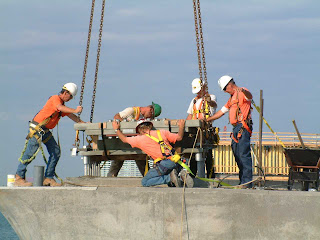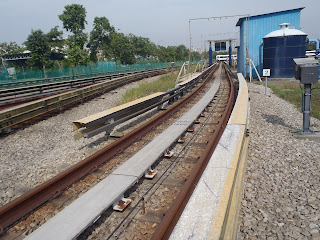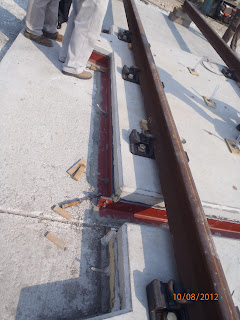All about Civil Engineering
All about Civil Engineering...
Saturday, December 29, 2012
Tuesday, December 18, 2012
Friday, November 9, 2012
Sunday, October 28, 2012
Tuesday, October 16, 2012
Tuesday, October 2, 2012
Monday, October 1, 2012
Cost for 2 Overhead Signage Gantry
Cost for 2 Overhead Signage Gantry at P79 and P87 is 165k...same price with 5 years old re-condition Estima. Hmmm...
Blast Wall at Stn 4
8 meters height Blast Wall is designed at Station 4. What is the function of this BLAST WALL?
Saturday, September 29, 2012
How to build a house using IBS system?
Build a house using IBS system, It's fast, clean, cheap, good quality and the most important thing is environmental friendly. But how to build a house using IBS system? This video will explain everyting, enjoy viewing...
Friday, September 28, 2012
Thursday, September 27, 2012
Wednesday, September 26, 2012
Plate Bearing
The Plate Bearing are devided into 2 type which is Top Plate Bearing & Bottom Plate Bearing.
Top Plate Bearing will be installed at the SBG while Bottom Plate Bearing will be installed at the Pier Head. Following are Hercules Plate Bearing photos:
Top Plate Bearing will be installed at the SBG while Bottom Plate Bearing will be installed at the Pier Head. Following are Hercules Plate Bearing photos:
Top Plate Bearing - Cylinder Type (to be slot in and cast inside the SBG)
Top Plate Bearing - Rectangular Type (to be slot in and cast inside the SBG)
Bearing Design By Hercules Engineering
Bearing Top Plate Sockets
Bearing design by Hercules Engineering were previously reviewed by DDC with comments that large and closely spaced bearing top sockets(less than 20mm gap) was not acceptable, as the sockets will clash with the SBG segment reinforcement T20. One sample was brought in to the meeting table for deliberation.
Socket gaps > 20mm but end plate gaps less than 20mm
Gap between sockets less than 20mm
Space Limitation At Segment Downstand
Hercules Engineering informed due to large bearing forces on curved spans, along with up-lift forces, space constraint on the segment down-stands limits the spacing of the bearing sockets.
Hercules Engineering informed that higher grade of steel was used in the bearing design i.e. upgrade from Grade 43A to Grade 53.
Bearing Forces at Curved Spans(R>215 )
25 cases in Package A, all at curved spans (both ST and DT) were identified with large bearing forces and up-lift forces, remained facing difficulty to have sockets spaces wide enough to avoid clash with the segment reinforcement.
Hercules Engineering to look into smaller socket size. Other option is to add another row of socket, or enlarge the bearing plate in one direction.
Hercules Engineering to revert back to DDC by next week Tuesday 02/Oct/2012.
Installation of Bearings At The Site
Due to rebar congestion at the pier head and at the RC up-stand plinths, Launching Contractor informed it was extremely difficult to launch the span in position precisely
Cutting Reinforcement at RC Plinths
The option of cutting some of the T20 reinforcement was discussed. DDC was not in fovour of cutting the re-bar. The bars are required to take care of the up-lift forces.
Hercules/MC/LC to explore the possibility to provide steel pins locked up with the bottom plate sockets to replace rebar in cases where the re-bars are inevitably forced to be cut-off.
DDC informed that cutting of the re-bars shall be treated as case by case, particular at areas where there are no up-lift forces.
Option To Widen Pier Head
MC was asked to study the possibility to widen the pier head from current 2.0m wide. A larger pier head will be able to accommodate a bigger bottom bearing plate.
LC/MC informed a larger pier head may be constraint by the current LG pier bracket design. The stressing bars used to secure the LG pier brackets may be too close to the surface of the pier head (25mm+/-). BBR to check and inform Minco.
Special Crossings – Bearing Movement
The construction drawing indicated the movement for the free bearing is 8mm. Hercules Engineering requested DDC to reduce the movement from 8mm to 5mm.
DDC will check and revert back to Hercules Engineering.
Tuesday, September 25, 2012
Launching Gantry - Animation
Launching Gantry is used to lauch the SBG for 18m, 21m, 24m, 27m, 33m and 36m span.
Segment Erector - Animation
This animation is for Low Type Segment Erector (SE) or some people called it Segment Lifter. This SE will be use in launching the SBG for 65m and 100m special crossing span. Balance Cantilever method will be use for lauching the SBG. Low type SE mean the SBG only can be lifted from the respective span, NOT from the apposite span. For High type SE, the SBG is be able to launch from either respective and opposite span...Its more flexsible but required higher space. High type SE is NOT suitable for high restricted area (due to HT overhead power cable ect)
Monday, September 24, 2012
Saturday, September 22, 2012
Tuesday, September 11, 2012
Go Precast
Engineers are to be more creative, innovative, and should be able to think out
of the box. Vast Paradigm Shift is urgently required in order to accommodate
for so called “Fast Track project” in construction industry in Malaysia. Conventional
methods of construction need to change. Cast in situ method which required
longer time, more manpower and large amount of material wastage need to be
re-examine. Only unwise engineer will design for cast in situ for
structure above busy expressway at Station 3. If I’m the client, the designer
will be penalize for providing me “non-construct-able” design. Common laa…
please visit the site and see how congested are the area, good engineer is not only be able to produce safe design but workable design. Go Pre-cast and all the problems resolve...Insyaallah.
Friday, September 7, 2012
Track Slab Grouting Mock-up
The System "Design and Build" Contractor has carry out a Mock-up for Track Slab Grouting on 10th August 2012 at the existing Depot. LanKo 702 Non Shrink Grout was used for that purposed. The cement Grout was pumped using pressure grout machine into the designed hole on top of the track slab. Maximum depth of the grouting thickness is 40mm. If the thickness required more than 40mm, reforcement is required to strengthern the structure. Steel plate was used as a formwork during the grouting process. Its seem to be work! No Leaking or Cement Bleeding occur.
NO REINFORCEMENT REQUIRED FOR GROUTING < 40mm Thickness.
Subscribe to:
Comments (Atom)


.JPG)














































